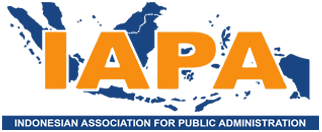Kerangka Kerja Collaborative Governance: Tantangan Implementasi Dalam Situasi Krisis Pandemi COVID19
Abstract
Dampak Covid-19 tidak ada bandingannya dalam sejarah modern. Dampaknya tidak hanya pada kesehatan tapi pada semua sektor: ekonomi, politik, sosial, budaya, lingkungan pendidikan. Covid19 menyebabkan krisis mengakibatkan ancaman bagi kelangsungan sistem nilai fundamental dalam masyarakat. Dampak Covid19 yang sangat kompleks tersebut, tidak dapat diselesaikan oleh satu organisasi, perlu melibatkan lintas sector. Paper ini bertujuan membahas beberaapa teori tentang collaborative governance sebagai dasar dalam rencana membangun keraangka kerja collabortive governance dalam situasi bencana. Penelitian collaborative governance dalam situasi bencana/krisis belum banyak dilakukan di Indonesia.Tema riset kolaborasi antar level pemerintahan (interagecy governance), kolaborrasi lintas sektor (cross-sector governance) dan kolaborasi pada tingkat komunitas (grassroot governance) dalam kerangka kerja kolaborasi situasi bencana perlu dilakukan. Paper ini merupaka hasil kajian teori tentang perkembangan teori administrasi publik, membahas tipologi interaksi organisi, perbedaan manajemen publik colaborative dan collaborative governance, nilai kolaborative, kerangka kerja kolaboraaative, tantangan dalan collaborative governance serta body of knowledge studi collaborative governance.
Downloads
References
Afsahi, A., Beausoleil, E., Dean, R., Ercan, S. A., & Gagnon, J. P. (2020). Democracy in a global emergency five lessons from the COVID-19 pandemic. Democratic Theory, 7(2), v–xix. https://doi.org/10.3167/dt.2020.070201
Agranoff, R., & McGuire, M. (2003). Collaborative public management : New strategies for local governments. USA: Georgetown University Press. Washington DC.
Agranoff, R., & Michael McGuire. (2003). Collabaorative public management. Washington, D.C., U.S.A: Georgetown University Press.
Ahrari, M. E. (1987). A Paradigm of ‘Crisis’ Decision Making: The Case of Synfuels Policy. British Journal of Political Science, 17(1), 71–91. https://doi.org/10.1017/S0007123400004610
Al-Qatawneh, S. S., Alsalhi, N. R., & Eltahir, M. E. (2019). The citizenship values included in intermediate stage Arabic-language textbooks and teachers’ awareness of them in the UAE: A case study. Heliyon, 5(11), e02809. https://doi.org/10.1016/j.heliyon.2019.e02809
Ann Marie Thomson, J. L. P. (2006). Collaboration Processes: Inside the Black Box. Public Administration Review, 1(December).
Ansell, C., & Gash, A. (2008). Collaborative governance in theory and practice. Journal of Public Administration Research and Theory, 18(4), 543–571. https://doi.org/10.1093/jopart/mum032
Bappelitbangda Provinsi NTT. Rancangan Awal Rencana Pembangunan Menengah Daerah Perubahan (RPJMD) Provinsi Nusa Tenggara Timur Tahun 2018 - 2023. , Bapelitbangda NTT § (2020).
Basu, R. (2019). Public administration in the 21st century. In Public Administration in the 21st Century. London and New York: Routledge 2 Park Square, Milton Park, Abingdon, Oxon OX14 4RN and.
Bhuiyan, S. H. (2010). A crisis in governance: Urban solid waste management in Bangladesh. Habitat International, 34(1), 125–133. https://doi.org/10.1016/j.habitatint.2009.08.002
Breitnauer, J. (2019). The Spanish Flu Pandmeic and its influence on history. Retrieved from www.penandswordbooks.com
Bryson, J. M., & Crosby, B. C. (2007). Leadership for the common good creating regimes of mutual gain. In R. S. Buss, M. T. F., & C. M. Foreword (Eds.), Transforming Public Leadership for the 21st Century (p. 185). USA: M.E.Sharpe Armonk, New York London, England.
Bryson, J. M., Crosby, B. C., & Stone, M. M. (2006). The design and implementation of cross-sector collaborations: Propositions from the literature. Public Administration Review, 66(SUPPL. 1), 44–55. https://doi.org/10.1111/j.1540-6210.2006.00665.x
Cheever, K. (2006). Collaborations in public service: Memphis experience. International Journal of Public Administration, 29(7), 533–555. https://doi.org/10.1080/01900690500452369
Chhotray, V., & Gerry, S. (2009). Governance theory and practice: A cross-disciplinary approach. In Human Rights and Ethics. https://doi.org/10.1057/9780230583344
Chrislip, D. D. (2002). The collaborative leadership fieldbook: A guide for citizens and civic leaders. In The Jossey-Bass nonprofit and public management series. USA.
Cleveland, H. (2002). Nobody in charge. In Angewandte Chemie International Edition, 6(11), 951– 952. Retrieved from www.josseybass.com
Cooper, T. L., Bryer, T. A., & Meek, J. W. (2006). Citizen-centered collaborative public management. Public Administration Review, 66(SUPPL. 1), 76–88. https://doi.org/10.1111/j.1540- 6210.2006.00668.x
Creswell;, J. W., & Creswell, J. D. (2018). Reserach design: Qualitative, quantitative and mixed methods approachs. In H. Salmon (Ed.), Sage Publication, Inc (Fifth). Los Angeles: Sage Publicatio, inc.
Dalglish, S. L. (2020). COVID-19 gives the lie to global health expertise. The Lancet, 395(10231), 1189. https://doi.org/10.1016/S0140-6736(20)30739-X
Diaz-Kope, L., & Miller-Stevens, K. (2015). Rethinking a typology of watershed partnerships: A governance perspective. Public Works Management and Policy, 20(1), 29–48. https://doi.org/10.1177/1087724X14524733
Dong, L. (2015). Public Administration Theories, Instrumental and Value Rationalities. In Palgrave Macmillan. https://doi.org/10.1017/CBO9781107415324.004
Eggers., S. G. and W. D. (2004). Governing by Network: The New Shape of the Public Sector,. In Washington, DC: Brookings Institution Press, (Vol. 29). https://doi.org/10.1002/pam
Elia, G., & Margherita, A. (2018). Can we solve wicked problems? A conceptual framework and a collective intelligence system to support problem analysis and solution design for complex social issues. Technological Forecasting and Social Change, 133(October 2017), 279–286. https://doi.org/10.1016/j.techfore.2018.03.010
Emerson, K., & Nabatchi, T. (2015a). Collaborative governance regime (R. Agranoff, M. Barzelay, A. O. Bowman, H. G. Fredericson, W. Gormley, R. O’Leary, ... D. H. Rosenbloom, Eds.). USA: Georgetown University Press Washington, DC.
Emerson, K., & Nabatchi, T. (2015b). Collaborative governance regimes. Retrieved from https://books.google.co.id/books?id=cE5gCwAAQBAJ&printsec=frontcover&dq=collaborative+gov ernance&hl=en&sa=X&ved=2ahUKEwi78NGplIXvAhVBOSsKHddnCjUQ6AEwAXoECAIQAg#v =onepage&q=collaborative governance&f=false
Emerson, K., & Nabatchi, T. (2015c). Collaborative governance regimes. In Collaborative Governance Regimes. https://doi.org/10.1111/padm.12278
Emerson, K., Nabatchi, T., & Balogh, S. (2011). An Integrative Framework for Collaborative Governance. Journal of Public Administration Research and Theory, (June 2009), 1–29. https://doi.org/10.1093/jopart/mur011
Emerson, K., Nabatchi, T., & Balogh, S. (2012). An integrative framework for collaborative governance. Journal of Public Administration Research and Theory, 22(1), 1–29. https://doi.org/10.1093/jopart/mur011
Falk, S., Rommele, A., & Silverman, M. (2017). Digital Government: Leveraging Innovation to Improve Public sector performance and outcomes for Citizens. In S. Falk, A. R€ommele, & M. Silverman (Eds.), Digital Government: Leveraging Innovation to Improve Public Sector Performance and Outcomes for Citizens. https://doi.org/10.1007/978-3-319-38795-6_7
Farazmand, A. (2017). Crisis and emergency management: Theory and practice. In Crisis and Emergency Management: Theory and Practice, Second Edition. https://doi.org/10.4324/9781315095264
Frederickson, H. G. (1991). Toward a Theory of The Public for Public Administration. Administration and Society, 22(no.4), 395–417. https://doi.org/0803973233
Frederickson, H. G., Smith, K. B., Larimer, C. W., & Licari, M. J. (2018). The public administration theory primer, third edition. In The Public Administration Theory Primer, Third Edition. https://doi.org/10.4324/9780429494369
Fredericsson, H. G., & Matkin, D. S. T. (2007). Public Leadership as Gardening. In Ricardo S. Morse, T. F. Buss, & C. M. Kinghorn (Eds.), Transforming Public Leadership for the 21st Century. Traansformaational trends in governance and democrasi (p. 42). London, England: M.E. Sharpe.
Gieseka, T. M. (2020). Collaborative environmental governance frameworks : A practical guide. In Taylor & Francis Group. USA: Taylor & Francis Group.
Gieseke, T. M. (2020). Collaborative Environmental Governance Frameworks A Collaborative environmental governace frameworks : A practical guide. In Journal of Chemical Information and Modeling (Vol. 53). USA: Taylor & Francis Group.
Gow, J. I., & Dufour, C. (2000). Is the new public management a paradigm? Does it matter? International Review of Administrative Sciences, 66(4), 573–597. https://doi.org/10.1177/0020852300664002
Gray, B. (1985). Conditions facilitating interorganizational collaboration. Human Relations, 38(10), 911–936. https://doi.org/10.1177/001872678503801001
Gray, B. (1989a). Collaboraating: Finding common ground for multypart problem. USA: Jossey-Bass.
Gray, B. (1989b). Collaborating: Finding common ground for multiparty problems. Retrieved from
https://www.wiley.com/en-
fr/Collaborating%3A+Finding+Common+Ground+for+Multiparty+Problems-p-9781555421595
Gunton, I. T., & Day, J. C. (2002). the role of biodiversity conservation in the transition to rural sustainability. The Theory and Practice of Collaborative Planning in Resource and Environmental
Management. Krakow, Poland.
Haque, M. (2020). The COVID-19 pandemic-A global public health crisis: A brief overview regarding
pharmacological interventions. Pesquisa Brasileira Em Odontopediatria e Clinica Integrada, 20, 1–
15. https://doi.org/10.1590/pboci.2020.137
Head, B. (2008). Wicked Problems in Public Policy. Public Policy, 3(2), 110–118.
Imperial, M. T. (2005). Using collaboration as a governance strategy: Lessons from six watershed
management programs. Administration and Society, 37(3), 281–320.
https://doi.org/10.1177/0095399705276111
Kapucu, N., Yuldashev, F., & Bakiev, E. (2009). Collaborative public management and collaborative
governance: Conceptual similarities and differences. European Journal of Economic and Political
Studies, 2(1), 39–60.
Keast, R., Brown, K., & Mandell, M. (2007). Getting the right mix: Unpacking integration meanings
and strategies. International Public Management Journal, 10(1), 9–33.
https://doi.org/10.1080/10967490601185716
Keller, L. F. (2007). Public Administration and the American Republic: The Continuing Saga of
Management and Administration in Politics. In J. Rabin;, W. B. Hildreth;, & G. J. Miller (Eds.), Hand
book of public aadministration (Third, p. 5). USA: Taylor & Francis Grop.
Kennett, P. (2008). Handbook of crisis and emergency management. In ممممم مم ممم(Vol. 4).
Retrieved from http://marefateadyan.nashriyat.ir/node/150
Kettl, Donal F. (2002). The transformation of governance. USA: The Johns Hopkins University Press.
Kettl, Donald F. (2006). Managing boundaries in American administration: The collaboration
imperative. Public Administration Review, 66(SUPPL. 1), 10–19. https://doi.org/10.1111/j.1540-
6210.2006.00662.x
Kuhn, T. S. (1970). The structure of scientific revolutions (Second; O. Neurath;, R. Carnap;, & C.
Moris, Eds.). London: The University of Chicag< Chicago 60637.
Kuhn, T. S. (1996). The structure of scientificrRevol ution (Third). Chicago and London: The
University of Chicag Press.
Kupperberg, P. (2008). Great historic disasters : The influenza pandemic on 1918-1919. Retrieved
from http://www.chelseahouse.com
Lupton, D., & Willis, K. (2021). Covid society. In D. Lupton & K. Willis (Eds.), The Covid-19 Crisis:
Social perspectives (pp. 1–3). USA: Routledge.
Margerum, R. D. (2002). Collaborative planning building consensus and building a distinct model for
practice. Journal of Planning Education and Research, 21(3), 237–253.
https://doi.org/10.1177/0739456X0202100302
Mcguire, M. (2006). Collaborative what we public management : Collaborative assessing know and
how we know it. 66, 33–43. Retrieved from http://www.jstor.org/stable/4096568 .
McNamara, M. (2012). Starting to untangle the web of cooperation, coordination, and collaboration: A framework for public managers. In International Journal of Public Administration (Vol. 35).
https://doi.org/10.1080/01900692.2012.655527
McNamara, M., & Morris, J. C. (2012). More than a one-ttrick pony: Exploring the contours of a multi-
sector covener. Journal for Nonprofit Management, 15(1), 84–103.
McNamara, M. W. (2016). Collaborative anagement and leadershp (J. C. Morris & K. Miller-Stevens,
Eds.). USA: Roudledge.
Megawati, S., Niswah, F., & Oktariyanda, T. A. (2020). Collaborative Governance as Handling
Efforts of Pandemic Covid-19 in Surabaya City. 473(April), 312–316.
https://doi.org/10.2991/assehr.k.201014.067
Moore, M. (1995). Creating Public Value_ Strategic Management in Government- (p. 28). p. 28. USA:
Harvard University Press.
Morris, J. C., & Stevens, K. M.-. (2016a). Starte of the knowledge in collaboration. In J. C. Morris &
K. M.- Stevens (Eds.), Advancing Collaboration Theory Models, Typologies, and Evidence (p. 6). New
York, NY 10017: Routledge 711 Third Avenue, New York, NY 10017.
Morris, J. C., & Stevens, K. M.-. (2016b). The State of Knowledge in Collaboration. In J. C. Morris &
K. M. Stevans (Eds.), Advancing collaboration theeory: Models, typologies and evidence. (pp. 1–13).
https://doi.org/0.1080/10967490601185716
Morse, Richardo S., & Buss, T. F. (2007). The transformation of public leadership. In L. A. Picard, \
Robert Groelsema, & T. F. Buss (Eds.), Transforming Public Leadership for the 21st Century (p. 5).
Armonk, New York London, England: M.E. Sharpe, Inc.,.
Norris-Tirrell, D., & Clay, J. A. (2017). Strategic collaboration in public and nonprofit administration
(1st Editio). https://doi.org/10.4324/9781315087658
Northouse, P. G. (2016). Leadership Theory and Practice. In Avancing Collaboration Theory: Models,
typopgies and evidence (Eighth Edi, p. 263). Mathura Road, New Delhi 110 044: SAGE Publications,
Inc. 2455.
Northouse, P. G. (2018). Introduction to leadership: Concepts and practice. In M. Stanley, L. Holmes,
& N. D. ELearning (Eds.), SAGE Publications India Pvt. Ltd. (Fourth Edi). United Kingdom: SAGE
Publications Asia-Pacific Pte. Ltd.
O’Leary, R., & Bingham, L. B. (2009). Collaborative public manager. New ideas for the Twenty-fistr
Century (L. B. Bingham, Ed.). Retrieved from www.press.georgetown.edu
O’Leary, R., & Vij, N. (2017). Collaborative public management: Where have we been and where are
we going? American Review of Public Administration, 42(5), 508.
https://doi.org/10.1177/0275074012445780
Osborne, D., & Gaebler, T. (1992). Catalytic government: Steering rather than rowing. In Reinventing
government: how the entrepreneurial spirit is tansforming the public sector.
https://doi.org/10.1111/b.9781444331899.2011.00023.x
Osborne, S. (2010). The New Public Governance? Emerging perspectives on the theory and practice
of public governance. In Routledge Taylor and Francis Group. USA.
Paul, E., Brown, G. W., & Ridde, V. (2020). COVID-19: Time for paradigm shift in the nexus between
local, national and global health. BMJ Global Health, 5(4), 1–5. https://doi.org/10.1136/bmjgh-2020-
002622
Presiden RI. KEPPRES No. 11 Tahun 2020 tentang Penetapan Kedaruratan Kesehatan Masyarakat
Corona Virus Disease 2019 (COVID-19) [JDIH BPK RI]. , Jaringan Dokumentasi dan Informasi
Hukum Nasional § (2020).
Presiden RI. Peraturan Pemerintah RI Nomor 21 tentang Pembatasan Sosial Bersekala Besar dalam
rangka percepaan penanganan Corona Virus Diseases (Covid19). , (2020).
Provan, K. G., & Kenis, P. (2008). Modes of network governance: Structure, management, and effectiveness. Journal of Public Administration Research and Theory, 18(2), 229–252.
https://doi.org/10.1093/jopart/mum015
Rhodes, R. A. . (1996). The new governance: Governing without government. Political Studies, XLIV.,
652–657.
Ring, P. S., & Van De Ven, A. H. (1994). Developmental Processes of Cooperative Interorganizational
Relationships. Academy of Management Review, 19(1), 90–118. https://doi.org/10.5465/amr.1994.9410122009

 Karolus Ngambut(1)
Karolus Ngambut(1)







